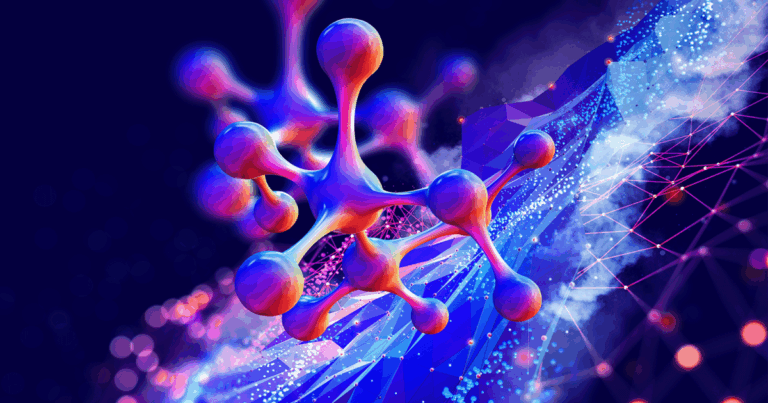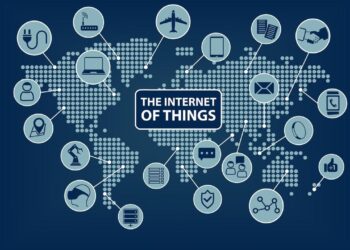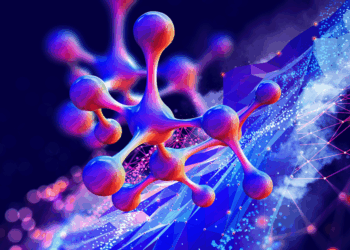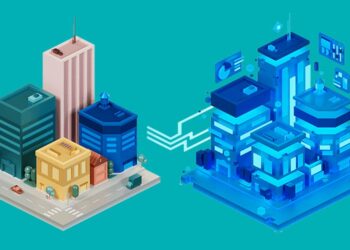The Nanoscale
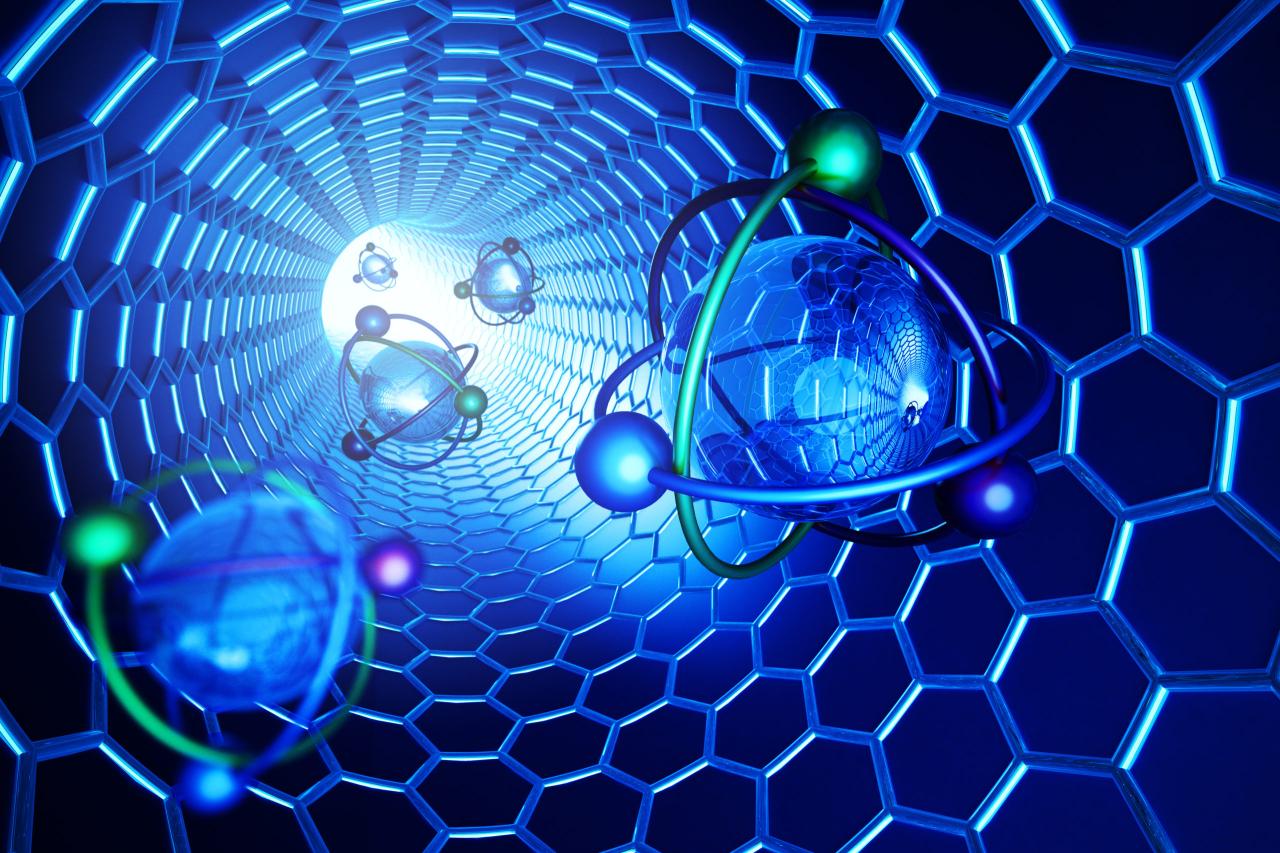
At the nanoscale, the rules of physics and chemistry often behave differently than in the macroscopic world, opening up a realm of novel properties and opportunities.
A. Quantum Effects
When materials are shrunk to the nanoscale, quantum mechanical effects become dominant, leading to unique properties not seen in larger forms of the same material.
- Surface Area to Volume Ratio: As particles get smaller, their surface area to volume ratio dramatically increases. This means a larger proportion of atoms are on the surface, where they can interact more readily, enhancing chemical reactivity and catalytic properties. For example, nanoscale catalysts can be far more efficient.
- Quantum Confinement: Electrons in nanoparticles become confined, leading to changes in their energy levels. This can alter electrical, optical, and magnetic properties. For example, quantum dots (semiconductor nanocrystals) emit light at specific, tunable wavelengths depending on their size, making them ideal for advanced displays or biological imaging.
- Mechanical Strength: Some materials exhibit increased strength or stiffness at the nanoscale, like carbon nanotubes, which are hundreds of times stronger than steel but six times lighter.
These unique quantum behaviors allow for the engineering of materials with tailor-made functionalities.
B. Building Blocks of Nanotech
Nanotechnology involves building from the bottom-up (assembling atoms and molecules) and refining top-down approaches (miniaturizing larger structures).
- Nanoparticles: Tiny particles, typically spherical, that range from 1 to 100 nm. Their properties often differ significantly from bulk materials due to quantum effects and high surface area. Examples include gold nanoparticles for drug delivery or titanium dioxide nanoparticles in sunscreens.
- Nanotubes: Cylindrical nanostructures, most famously carbon nanotubes, which are sheets of graphene rolled into a tube. They possess extraordinary strength, electrical conductivity, and thermal conductivity.
- Nanowires: One-dimensional nanostructures with diameters typically less than 100 nm, used in electronics and sensing.
- Nanofilms/Nanolayers: Extremely thin layers of material (often only a few atoms thick) with specialized properties for coatings, sensors, and electronics.
- Nanocomposites: Materials that incorporate nanoparticles into a larger matrix to enhance properties like strength, heat resistance, or barrier performance.
Understanding and controlling these basic building blocks is fundamental to designing sophisticated nanotechnologies.
C. Tools of the Nanoscale
The development of specialized tools was critical for nanotech to move from theory to practice.
- Scanning Tunneling Microscope (STM): Invented in 1981, this microscope allows scientists to “see” individual atoms and manipulate them, literally moving atoms one by one.
- Atomic Force Microscope (AFM): Similar to STM, AFM uses a sharp probe to scan a surface and generate a topographical map, allowing imaging of non-conductive materials and even measuring forces at the nanoscale.
- Electron Microscopes (TEM, SEM): Transmission Electron Microscopes (TEM) and Scanning Electron Microscopes (SEM) provide extremely high-resolution images of nanostructures.
- Nanofabrication Techniques:
- Lithography: Top-down techniques (like photolithography used in semiconductor manufacturing) are being refined to create smaller and smaller features.
- Self-Assembly: Bottom-up methods where molecules or nanoparticles spontaneously organize into ordered structures, mimicking biological processes. This is key for creating complex nanostructures efficiently.
- Chemical Synthesis: Precise chemical reactions to create nanoparticles, nanowires, and other nanostructures with controlled size, shape, and composition.
These tools enable scientists to both observe and actively engineer at the atomic and molecular levels.
Nanotech’s Transformative Impact Across Industries
The pervasive influence of nanotechnology is not limited to laboratories; it is actively revolutionizing diverse sectors, promising unprecedented advancements and efficiencies.
A. Medicine and Healthcare
Nanotech is transforming medicine, enabling breakthroughs in diagnostics, drug delivery, and regenerative medicine.
- Targeted Drug Delivery: Nanoparticles can be engineered to encapsulate drugs and deliver them precisely to diseased cells (e.g., cancer cells) while minimizing harm to healthy tissue. This reduces side effects and increases drug efficacy.
- Advanced Diagnostics: Nanosensors can detect disease biomarkers at extremely low concentrations, enabling earlier and more accurate diagnosis of diseases like cancer, infectious diseases, and neurodegenerative disorders.
- Medical Imaging: Quantum dots and other fluorescent nanoparticles can be used as highly sensitive contrast agents for improved imaging techniques, providing clearer views of tissues and tumors.
- Regenerative Medicine: Nanomaterials provide scaffolds for tissue engineering, guiding cell growth to repair or replace damaged tissues and organs.
- Antimicrobial Nanoparticles: Nanoparticles of silver or zinc oxide can be incorporated into wound dressings, medical devices, or textiles to combat antibiotic-resistant bacteria.
- DNA Sequencing: Nanopore sequencing technologies allow for rapid and cost-effective DNA sequencing by threading DNA strands through nanoscale pores.
B. Electronics and Computing
Nanotech is fundamental to the continued miniaturization and increased performance of electronic devices.
- Next-Generation Transistors: Nanoscale transistors (e.g., FinFETs, gate-all-around FETs) enable more powerful and energy-efficient microprocessors, pushing the limits of Moore’s Law.
- Flexible and Transparent Electronics: Developing conductive nanowires and transparent films for flexible displays, wearable electronics, and smart windows.
- Quantum Computing Components: Nanostructures are crucial for building and controlling qubits, the fundamental units of quantum computers.
- Advanced Memory: Nanomaterials are being explored for non-volatile memory technologies that are faster, denser, and more energy-efficient than current options.
- Nanoscale Sensors: Highly sensitive and compact sensors for environmental monitoring, smart homes, and personal devices.
C. Energy
Nanotechnology is critical for addressing global energy challenges, from generation to consumption.
- More Efficient Solar Cells: Nanostructured materials can improve the efficiency of solar panels by better absorbing sunlight and converting it into electricity. Innovations include thin-film solar cells and quantum dot solar cells.
- Advanced Batteries: Nanomaterials (e.g., silicon nanowires in anodes, graphene in cathodes) enhance battery capacity, charging speed, and lifespan for electric vehicles and grid-scale storage.
- Fuel Cells: Nanocatalysts improve the efficiency and reduce the cost of fuel cells, making hydrogen fuel more viable.
- Hydrogen Production and Storage: Nanomaterials can act as more efficient catalysts for hydrogen production and as advanced storage media for hydrogen.
- Thermoelectric Devices: Nanostructures can more efficiently convert waste heat into electricity.
D. Manufacturing and Materials Science
Nanotech is enabling the creation of materials with unprecedented properties.
- Lightweight and Strong Composites: Nanoparticles (e.g., carbon nanotubes, graphene) are added to polymers or metals to create materials that are lighter, stronger, and more durable for aerospace, automotive, and construction industries.
- Self-Healing Materials: Coatings or materials embedded with nanoscale capsules that release healing agents when cracks appear, extending product lifespan.
- Smart Coatings: Nanocoatings that are scratch-resistant, anti-corrosion, self-cleaning (hydrophobic/hydrophilic), anti-reflective, or provide thermal insulation for various surfaces.
- Advanced Filtration: Nanofibers and membranes with nanoscale pores for highly efficient water purification, air filtration, and industrial separations.
- Sustainable Manufacturing: Nanocatalysts reduce energy consumption and waste in chemical processes.
E. Agriculture and Food
Nanotechnology offers solutions for improving food production, preservation, and safety.
- Precision Agriculture: Nanosensors monitor soil quality, crop health, and nutrient levels, allowing for precise application of water, fertilizers, and pesticides.
- Nanopesticides/Nanofertilizers: Delivering pesticides and fertilizers more efficiently and with less environmental impact.
- Food Packaging: Nanomaterials in packaging can extend shelf life by improving barrier properties, detecting spoilage, or releasing antimicrobials.
- Food Safety Diagnostics: Nanosensors for rapid and sensitive detection of pathogens, toxins, or allergens in food products.
- Controlled Release Systems: Nanocapsules can deliver nutrients or additives to plants or animals at optimal times.
The Challenges and Hurdles for Nanotech
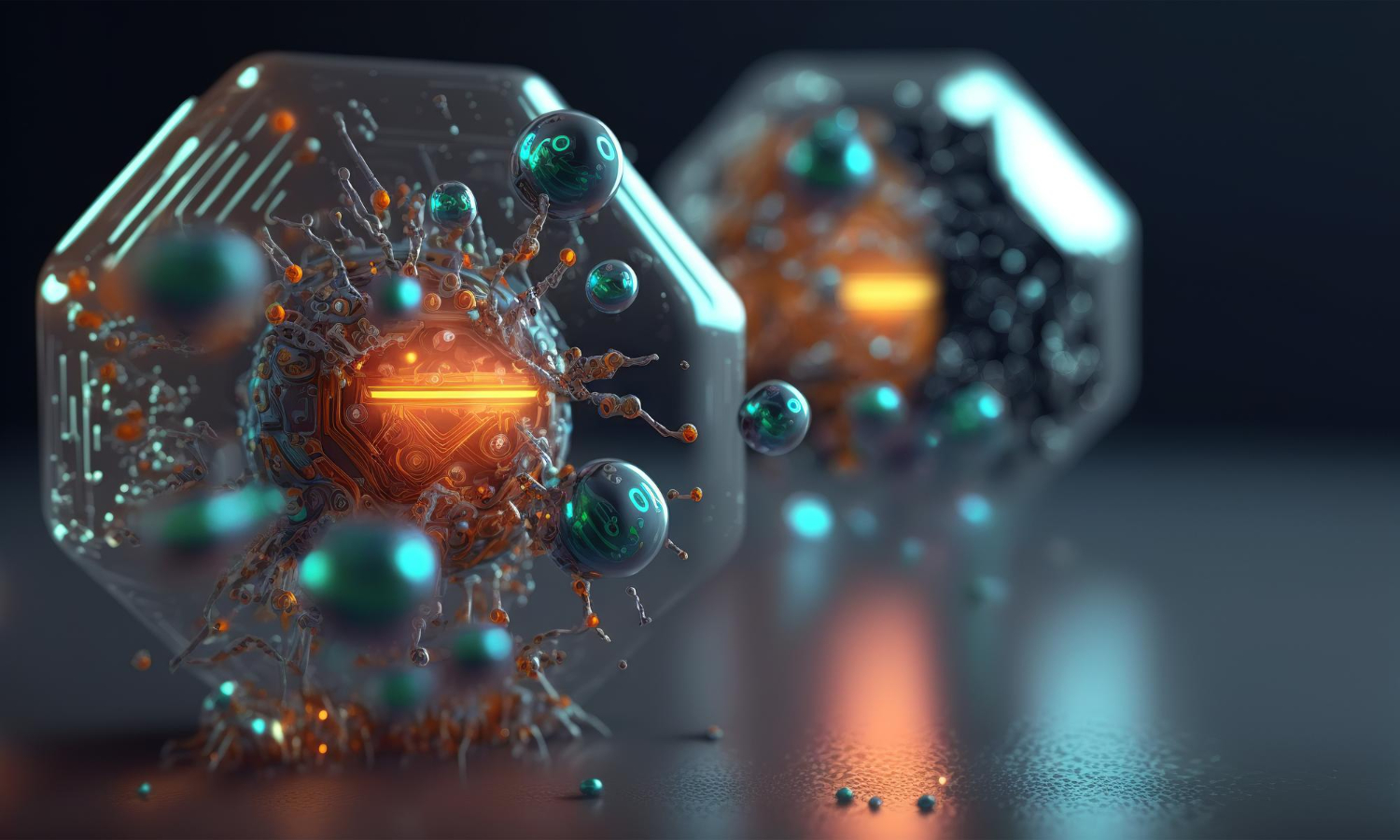
Despite its vast potential, nanotechnology faces significant scientific, ethical, and societal challenges that must be addressed for its responsible and widespread adoption.
A. Safety and Ecotoxicity
The unique properties of nanomaterials, while beneficial, also raise concerns about their impact on human health and the environment.
- Human Health Impacts: Concerns about engineered nanoparticles entering the human body (e.g., through inhalation or skin absorption) and their potential effects on organs, cells, or DNA, especially for long-term exposure. Research into their biocompatibility and toxicity is ongoing.
- Environmental Release: The potential for nanoparticles to be released into air, water, and soil, and their long-term effects on ecosystems, including effects on microorganisms, plants, and aquatic life.
- Risk Assessment: Developing robust methods to assess the risks associated with various nanomaterials, as their behavior at the nanoscale can differ from bulk materials.
- Lack of Long-Term Studies: Many studies on the safety of nanomaterials are still relatively short-term, necessitating more extensive research.
B. Scalability and Manufacturing Challenges
Producing nanomaterials and nanodevices at industrial scale can be difficult and costly.
- Precision Manufacturing: Achieving atomic-level precision consistently and affordably in large-scale production.
- Yield and Purity: Maintaining high yield and purity of nanomaterials during synthesis.
- Cost of Production: Current production methods for some advanced nanomaterials (e.g., carbon nanotubes, quantum dots) can be expensive, limiting widespread commercialization.
- Integration with Existing Processes: Seamlessly integrating nanotech into existing manufacturing lines.
C. Regulation and Ethical Governance
The rapid pace of nanotech innovation often outpaces regulatory frameworks.
- Regulatory Lag: Existing regulations are often not designed for materials with nanoscale properties, leading to uncertainty for manufacturers and consumers.
- Definition and Classification: Challenges in consistently defining and classifying nanomaterials for regulatory purposes.
- Ethical Concerns: Debates around the broader societal implications of manipulating matter at the atomic scale, including potential for unintended consequences or misuse.
- Public Engagement: Ensuring public understanding and trust through transparent communication and engagement about the risks and benefits.
D. Economic Viability and Market Adoption
Translating scientific breakthroughs into commercially successful products.
- High Research and Development Costs: Nanotech R&D requires significant investment.
- Proof of Concept to Commercialization: Bridging the gap between lab-scale demonstrations and economically viable, scalable products.
- Consumer Acceptance: Overcoming public skepticism or lack of awareness about nanotech products.
- Niche Markets vs. Mass Adoption: Many early nanotech applications find success in high-value niche markets before broader adoption.
E. Interdisciplinary Nature and Collaboration
Nanotechnology is highly interdisciplinary, requiring collaboration across various scientific and engineering fields.
- Bridging Disciplines: Fostering effective collaboration between physicists, chemists, biologists, materials scientists, engineers, and ethicists.
- Workforce Development: Training a skilled workforce capable of working at the nanoscale.
The Future of Nanotech
Despite the challenges, the trajectory for nanotechnology is one of accelerating discovery, deeper integration, and increasing ubiquity, moving towards a future where its marvels are subtly woven into the fabric of our everyday lives.
A. Self-Assembling Nanosystems and Molecular Machines
The ultimate dream of “bottom-up” nanotechnology.
- Autonomous Nanobots: Theoretical nanoscale robots capable of performing complex tasks (e.g., targeted drug delivery, manufacturing at the molecular level).
- Self-Healing Materials: More advanced materials that can autonomously repair damage without external intervention.
- Adaptive Systems: Nanomaterials that can change their properties in response to environmental stimuli.
- DNA Nanotechnology: Using DNA as a programmable building block to create complex, self-assembling nanostructures and molecular machines.
B. Integration with AI and Advanced Computation
AI and ML are supercharging nanotech research and discovery.
- AI-Driven Material Discovery: AI can sift through vast databases of potential nanomaterials and predict their properties, accelerating the discovery of new materials with desired functionalities.
- Automated Nanofabrication: AI-controlled robots and precise instruments for automated synthesis and assembly of nanostructures.
- Simulation and Modeling: Advanced computational models (often AI-enhanced) to simulate the behavior of atoms and molecules, guiding experimental design and predicting nanotech properties.
- Data Analysis: AI processes the massive datasets generated by nanoscale imaging and characterization tools.
C. Personalized Medicine and Theranostics
Nanotech will enable highly individualized healthcare.
- Real-time Health Monitoring: Wearable nanosensors that continuously monitor biomarkers and provide immediate health insights.
- Theranostics: Combining diagnostic and therapeutic capabilities in a single nanodevice, allowing for precise diagnosis and targeted treatment simultaneously.
- Immuno-Nanotechnology: Designing nanoparticles to modulate the immune system for fighting cancer or autoimmune diseases.
D. Energy Harvesting and Storage Breakthroughs
Addressing the energy crisis through nanoscale innovation.
- Ultra-Efficient Solar Cells: Achieving theoretical limits of solar energy conversion with advanced nanomaterials.
- Next-Gen Batteries: Revolutionary battery technologies with unprecedented energy density, charge cycles, and safety, potentially powered by new nanochemistry.
- Sustainable Energy Generation: Exploring novel nanomaterial-based approaches for geothermal, tidal, and even nuclear fusion energy.
E. Advanced Environmental Solutions
Nanotech will be critical for a cleaner, healthier planet.
- Highly Efficient Filters: Nanofiber membranes for complete removal of microplastics, pharmaceuticals, and emerging contaminants from water and air.
- CO2 Conversion: Nanocatalysts for more efficient and cost-effective conversion of captured CO2 into useful products or permanent storage.
- Pollution Sensors: Ubiquitous, highly sensitive nanosensors for real-time environmental monitoring.
Conclusion
Nanotech: Tiny Wonders is a profound testament to humanity’s ability to manipulate the very building blocks of matter and unlock unprecedented possibilities. From revolutionizing medicine with targeted therapies and empowering electronics with faster components to creating stronger materials and forging sustainable energy solutions, the impact of nanotechnology is pervasive and transformative. While significant challenges related to safety, scalability, and ethical governance remain, the relentless pace of innovation, fueled by convergence with AI and advanced manufacturing techniques, ensures its continued evolution. As we learn to wield the power of the nanoscale with increasing precision and responsibility, nanotechnology promises an era where materials are engineered from the ground up, diseases are combated at the cellular level, and the physical world itself is imbued with intelligent new functionalities. The future is being built, atom by atom, and the smallest scales are yielding the biggest breakthroughs.

